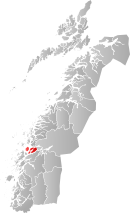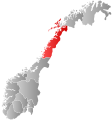Nesna
| Nesna kommune | |||
|---|---|---|---|
| Municipality | |||

|
|||
|
|||
 Nesna within Nordland |
|||
| Coordinates: 66°15′28″N 13°2′6″E / 66.25778°N 13.03500°ECoordinates: 66°15′28″N 13°2′6″E / 66.25778°N 13.03500°E | |||
| Country | Norway | ||
| County | Nordland | ||
| District | Helgeland | ||
| Administrative centre | Nesna | ||
| Government | |||
| • Mayor (2011) | Marit Bye (H) | ||
| Area | |||
| • Total | 183.13 km2 (70.71 sq mi) | ||
| • Land | 181.34 km2 (70.02 sq mi) | ||
| • Water | 1.79 km2 (0.69 sq mi) | ||
| Area rank | 342 in Norway | ||
| Population (2011) | |||
| • Total | 1,808 | ||
| • Rank | 346 in Norway | ||
| • Density | 10.0/km2 (26/sq mi) | ||
| • Change (10 years) | -5.5 % | ||
| Demonym(s) | Nesnaværing | ||
| Time zone | CET (UTC+1) | ||
| • Summer (DST) | CEST (UTC+2) | ||
| ISO 3166 code | NO-1828 | ||
| Official language form | Bokmål | ||
| Website | www |
||
|
|
|||
Nesna is a municipality in Nordland county, Norway. It is part of the Helgeland traditional region. The administrative centre of the municipality is the village of Nesna. Other villages in Nesna include Handnesneset, Husby, Saura, and Vikholmen.
The municipality consists of the three islands Tomma, Hugla (known as "Hugløy" by its inhabitants), and Handnesøya, and one peninsula that bears the name of the municipality, Nesna. The old Husby Estate is headquartered in Husby on Tomma island.
The Coastal Express arrives two times a day at the port of Nesna, the northbound arrives 05:30 and the southbound 11:15. The village of Nesna is also home to Nordland's education center Nesna University College, and there is also the KVN High School, and Nesna Church.
Nesna was established as a municipality on 1 January 1838 (see formannskapsdistrikt). The western district of Nesna (population: 1,348) was separated from Nesna on 1 July 1888 to form the new municipality of Dønnes. This left Nesna with 2,958 residents. On 1 January 1919, the Bardalssjøen farm (population: 4) was transferred from Hemnes to Nesna. In 1945, a small area of southern Nesna (population: 26) was transferred to Leirfjord.
On 1 January 1962, part of the island of Løkta (population: 80) was transferred from Nesna to Dønna and part of the island of Tomma (population: 80) was transferred from Dønnes to Nesna. Then on 1 January 1964, the Bardalssjøen area of Nesna, located south of the Ranfjorden, was transferred to Leirfjord. On that same date, the part of Nesna around the inner part of the Sjona fjord was transferred to Rana.
...
Wikipedia


